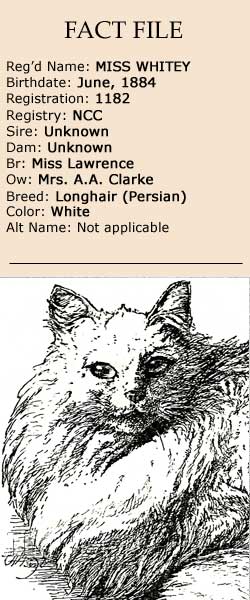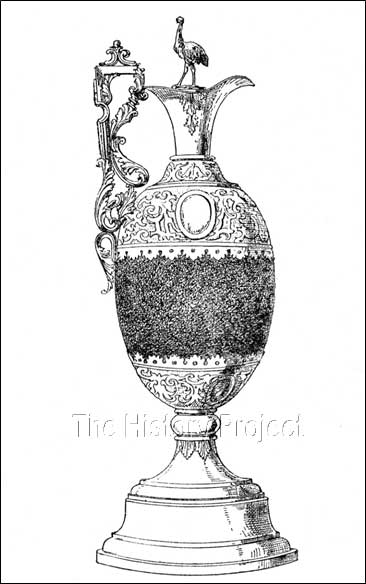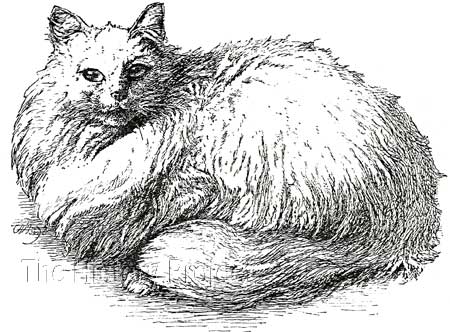 | |||||||||||||||









|
MISS WHITEY (1884)PHOTOS | SOCIAL MEDIA | REFERENCES
HISTORICAL BACKGROUND:The appearance of 'Miss Whitey' on the show bench was most timely. Born in 1884, she appeared in full maturity during the 1888 show season, just as Harrison Weir was gathering material, writing for and illustrating the text of his epic work Our Cats, which was subsequently published by R. Clements & Company in 1889. He himself described her at the height of her achievements: "Mr. A. A. Clarke's extremely beautiful White Persian She-Cat, "Miss Whitey". At the Crystal Palace Show in 1888, first in her class, taking the Crystal Palace silver medal for the best female cat in the section, the silver-mounted Doulton ware five o'clock tea set for the best long-haired cat in the exhibition, the gold medal given by the National Cat Club for the best long-haired cat belonging to a member, the National Cat Club Challenge Cup, and also the winner of numerous first prizes elsewhere....."2 It is therefore also duly appropriate, that Harrison Weir saw fit to take the trouble to draw an image of 'Miss Whitey' and to use it to utilize it to illustrate his 'Points of Excellence' for the 'White Longhaired Cat' on Page 140/141 of this classic work, an image of which is shown in both the 'Illustrations' and 'Social Media' sections.
Mr. Weir also gives us a significant insight to the early history of Longhairs, and of Whites in particular: "There are several varieties - the Russian, the Angora, the Persian and Indian. Forty or fifty years ago,(Editor: circa 1830's), they used to all be called French cats, as they were mostly imported from Paris - more particularly the white, which were then the fashion, and, if I remember rightly, they, as a rule, were larger than those of the present day. Coloured long-haired cats were then rare, and but little cared for or appreciated. The pure white, with long silky hair, bedecked with blue or rose- colour ribbon, or a silver collar with its name inscribed thereon or one of scarlet leather studded with brass, might often be seen stretching its full lazy length on luxurious woollen rugs - the valued, pampered pets of 'West-End' life."2 From this we clearly see that this suggests the development of the White Persian, among other varieties, having its roots in a mixed ancestry and that this may have had its beginnings in France. It is also important to remember that the Blue Persian, in some instances, came out of matings between Black Longhaired cats (carrying dilute) and White Longhaired cats that masked and/or carried dilute. PARENTAGE & OWNERSHIP:Mr. & Mrs. A. A. Clarke, who were based at the Langham Hotel, in Hastings, can be counted among the very first of the major breeders of Long-haired White cats during the 1880's and 1890's. Many other breeders had their foundation, or their own lines supplemented with cats coming from out of the Clarke's bloodstock; including such breeders as the Hon. Mrs. McLaren Morrison, Mrs. Louisa Herring, and Mrs. Cockburn Dickinson.
Unknown
Unknown
| Unknown
Miss Whitey, Jun-1884, White, F
| Unknown
Unknown
Unknown
Of particular note, is that one of the first foundation Blue males, 'Turco' (NCC: 1183), styled as a 'Self Blue', belonged to the Clarke's (formerly owned by Lady Gaskel). This singular male has had an incalculable impact on the foundation of the Persian breed. Just two of his first tier sons to have an impact on the breed are 'Pasha' (NCC: 1157), and 'The Friar' (NCC: 1212), the latter of which, is the sire of the tier two males, 'Lindfield Bootles' (NCC: 1226) and 'Romaldkirk Toga' (NCC: 1954). ¹ However, 'Miss Whitey' is listed in the Register as bred by Miss Lawrence, and owned by Mrs. A. A. Clarke. Miss Lawrence is virtually unknown, whereas Mr. Clarke is listed in the Register as the first and present Treasurer of the National Cat Club. It is also interesting to note that one of the Clarke's own Blue Persian females, was 'Nanette' (NCC: 1282), bred by Miss Frances Simpson, sired by her 'Beauty Boy' (NCC: 1031) and out of her phenomenal foundation female 'Mater' (NCC: 1094). ¹ Although the Clarke's bred long-hairs in a wide variety of colours, their first claim to fame was definitely as the breeders of top quality whites. SIBLINGS & SHOWS:Although there is no definitive proof of any siblings to 'Miss Whitey', it seems remotely possible that the well-known male, 'Timothy' (NCC: 1184), could have been a sire-sibling, having been born in December 1884, bred out of a female named 'Tibbs'. 'Timothy' has no sire listed, but is similarly featured as an example of the White Persian in Harrison Weir's classic work Our Cats (1889).
BREEDING & PROGENY:No progeny of 'Miss Whitey' are recorded.
PHOTOS:
SOCIAL MEDIA :
In Summary: 'Miss Whitey', & 'Tim', owned by Mr. & Mrs. A. A. Clarke, represent the growing interest in Long-haired cats as show specimens during the 1880's, during which the solid colours of White and Black had considerable influence and success. Mr. Clarke, acted as both the Treasurer of the National Cat Club from its inception, but also when the time came, as the National Recorder and Compiler of the Stud Books & Register. Although the Whites remained popular, the rise of the Blue Persian was just around the corner, and in the 1890's the Blues rose to new heights, challenging the supremacy of the White. The Chinchilla was also gaining in popularity, so that by the turn of the century, it was anyone's guess as to which of these three favourite Long-haired varieties would conquer at shows. By winning the National Cat Club's Challenge Cup, 'Miss Whitey' had set the bar high, early on, and now it was up to other Longhairs to attempt to follow. REFERENCES:
Registers associated with this article include The Incorporated Cat Fanciers Association of Great Britain (TICFAGB), National Cat Club (NCC), The Cat Club (CCR), Beresford Cat Club (BCC), Feline Federation Francaise (FFF), Siamese Cat Registry (SCR), US Register & Studbook for Cats (USR)including Supplement(USRS), The Studbook of the American Cat Association (ACA), and the Studbook & Register of the Cat Fanciers' Association (CFA).
|
||||||||||||||
Home | Cats | Gallery | Clubs | People | Artifacts | Articles | Updates | Contact Us ©The CFA Foundation, Inc and The Harrison Weir Collection
|
|||||||||||||||





